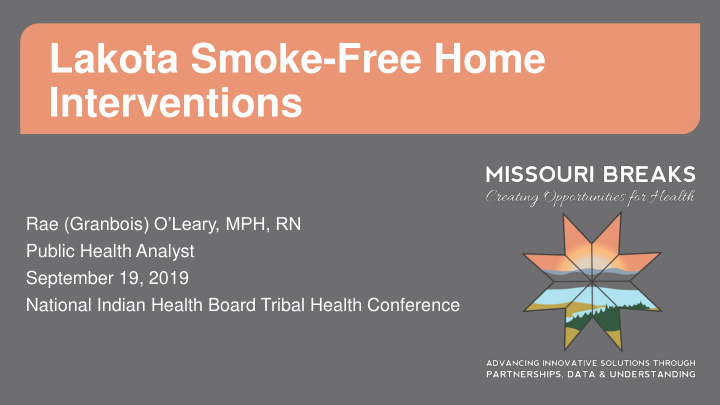



Lakota Smoke-Free Home Interventions Rae (Granbois ) O’Leary, MPH, RN Public Health Analyst September 19, 2019 National Indian Health Board Tribal Health Conference
Overview • Secondhand smoke initiatives of the Canli Coalition of the Cheyenne River Sioux Tribe • Study of secondhand smoke intervention with Oglala Sioux Tribe households • Study to promote smoke-free homes in Lakota communities
Background • Secondhand smoke (SHS) is a Class A Carcinogen. • SHS exposure increases risk for lung cancer, respiratory diseases, low birthrate, and other diseases. • Carcinogenic compounds (NNAL, NNK) found in urine of smokers and nonsmokers exposed to SHS. • Lakota Tribes have smoking rates as high as 50% for both men and women. • High smoking rates has led to high rates of secondhand smoke exposure.
Canli Coalition of CRST Secondhand Smoke Initiatives
Canli Coalition of CRST Secondhand Smoke Initiatives: Parks
Canli Coalition of CRST Secondhand Smoke Initiatives: Pledges
Canli Coalition of CRST Secondhand Smoke Initiatives: Apartments
Canli Coalition of CRST Secondhand Smoke Initiatives: Healthcare • Train AND retrain clinicians to document secondhand smoke exposure in medical record • ICD- 10 code Z77.22 for “secondhand tobacco smoke”
Canli Coalition of CRST Secondhand Smoke Initiatives: Lakota Values • Compassion • Wisdom • Bravery • Honor • Respect • Humility • Generosity • Love • Educate • Truth • Sacrifice • Perseverance • Fortitude
Canli Coalition of CRST Secondhand Smoke Initiatives: Children’s Book https://www.youtube.com/watch?v=UblwicZUTjk&t=2s
Secondhand Smoke Intervention with OST: Overview Randomized • 110 families (one smoker and one potty- trained child) Measures collected • Detailed questionnaire • Ambient nicotine in air (dosimeter) in intervention and control • Urine biomarkers from potty-trained child • Cotinine (metabolite of nicotine) • NNAL (tobacco-specific carcinogen found in urine of nonsmoker)
Secondhand Smoke Intervention with OST: Results Table 1. Child Biomarker Data Documenting Exposure To Tobacco Median (IQR) TOTAL Active Control P Baseline Child Cotinine, 7 (3, 22) 7.5 (4, 17.5) 6.5 (2, 31) NS ng/mL Child NNAL, 14.6 (6.3, 35.7) 17.0 (6.3, 32.2) 12.1 (4.5, 44.3) NS pg/mL
Secondhand Smoke Intervention with OST: Results 1 o Outcome , Passive Nicotine Dosimeter Active Control P Baseline – Week -0.42 (1.55, 0.02) -0.31 (-1.68, 0.10) NS 12, median (IQR)
Secondhand Smoke Intervention with OST: Results 1 o Outcome , Child Cotinine Active Control P Baseline – Week 12, median (IQR) 0 (-4, 4) 0 (-10.5, 3) NS
Secondhand Smoke Intervention with OST: Results Table 2. Secondary Outcomes at Week 12 Active Control P Self-report complete in-home 41% 21% 0.05 smoking restrictions Quit smoking >1 time since 46% 26% 0.05 baseline CPD, change from baseline -1.5 (-4.5, 0) 0.5 (-3, 0) NS
Secondhand Smoke Intervention with OST: Conclusions • Biomarker feedback was marginally significant for self-reported complete in-home smoking restrictions and quit attempts. • No associated change in child biomarker exposure • It is possible that children are being exposed elsewhere. • Children may be ingesting residual nicotine remaining on surfaces after the cigarette is extinguished (thirdhand smoke).
Promoting Smoke Free Homes on CRST • Completed and analyzed 13 KI Interviews with people who independently made their homes smoke-free • Developed a Tribal Advisory Board • Created intervention materials • Currently testing the intervention and biomarker feedback with a randomized controlled trial (n=138)
Acknowledgements • The Canli Coaliton of CRST has been primarily funded by the South Dakota Department of Health and American Non-Smokers Rights Foundation • Secondhand Smoke Intervention among Lakota Households was performed under the auspices of the Collaborative to Improve Native Cancer Outcomes, a P50 project sponsored by the National Cancer Institute (grant no. P50CA148110; PIs D. Buchwald and J. Henderson). • Promoting Smoke-Free Homes in Lakota Communities is funded by the National Institutes of Health National Institute of Environmental Health Sciences (grant no. 1R01FS027793-02; PI P. Nez Henderson) • All research was approved by the respective Tribes and the Great Plains Area Indian Health Service IRB and advised by respective Tribal Advisory Boards.
Pilamaya! | Thank You! 605.964.1260 Email address www.missouri-breaks.com/ @MissouriBreaks1 www.facebook.com/MissouriBreaksResearch/
Recommend
More recommend